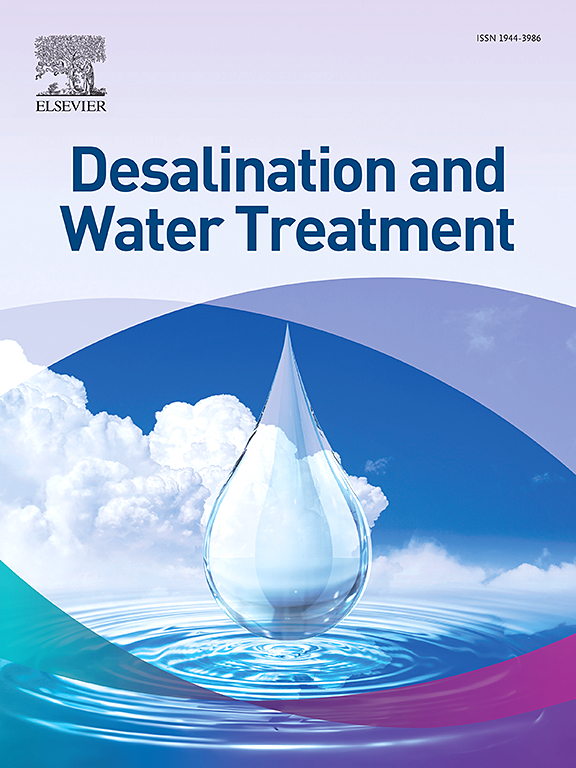多组分体系中Pb(II)离子同时去除亚甲基蓝和直接蓝71:多组分Langmuir模型的应用
IF 1
4区 工程技术
Q4 ENGINEERING, CHEMICAL
引用次数: 0
摘要
本研究旨在研究同时去除亚甲基蓝(MB)、直接蓝71 (DB71)和铅(II)离子,这三种离子在纺织、造纸、皮革、油漆和塑料等工业废水中经常以高浓度共存。采用吸附法研究了MB和DB71同时去除二元混合物中的Pb(II)离子。采用磁性高岭土纳米管-海藻酸盐(MHNTs-ALG)杂化微珠从二元吸附介质中去除这些成分。为此,采用“共沉淀法”获得了高岭土纳米管的磁性能。采用挤压滴法制备了磁性高岭土纳米管(MHNTs)和海藻酸盐(ALG)生物聚合物。根据所合成的MHNTs-ALG杂化微珠在二元混合物中的阴离子和阳离子污染物含量,考察了它们的吸附能力和效率,并以单一体系为对照,考察了它们之间的协同和拮抗作用。利用平衡吸附数据考察了其与二元体系多组分Langmuir吸附模型的相容性,并计算了表征吸附容量和亲和力的常数值。在Pb(II)-MB二元混合物中,根据多组分Langmuir模型计算,单位吸附剂重量对Pb(II)和MB的最大吸附量分别为248.46 mg/g (q Pb, m)和946.92 mg/g (q MB, m)。二元体系对Pb(II)和Direct Blue 71的最大吸附量分别为203.14 mg/g (q Pb, m)和118.96 mg/g (q DB71, m)。与单独吸附Pb(II)离子相比,Pb(II)和MB的共存产生了协同作用,而与单独吸附MB相比,Pb(II)离子的共存产生了拮抗作用。与单独存在的Pb(II)离子相比,Pb(II)和DB71离子的共存形成了协同效应,与单独存在的DB71离子相比,形成了拮抗协同混合效应。本文章由计算机程序翻译,如有差异,请以英文原文为准。
Simultaneous removal of Methylene Blue and Direct Blue 71 with Pb(II) ions from multi-component systems: application of the multi-component Langmuir model
This study aims to investigate the simultaneous removal of Methylene Blue (MB), Direct Blue 71 (DB71), and Pb(II) ions, which are frequently found together at high concentrations in different industrial wastewaters, such as textile, paper, leather, paint, and plastic manufacturing waste- waters. The simultaneous removal of Pb(II) ions with MB and DB71 from binary mixtures was investigated by the adsorption method. Magnetic halloysite nanotubes-alginate (MHNTs-ALG) hybrid beads were used to remove these components from the binary adsorption media. For this purpose, a magnetic property was gained to halloysite nanotubes using the “co-precipitation method”. Magnetic halloysite nanotubes (MHNTs) were composited with alginate (ALG) biopoly - mers through the “extrusion dripping method”. The adsorption capacities and efficiency of these synthesized MHNTs-ALG hybrid beads were investigated according to their anionic and cationic pollutant content in binary mixtures, and the synergistic and antagonistic effects of these compo- nents on each other were investigated by comparing them according to single systems. The compatibility with the multi-component Langmuir adsorption model for binary systems was examined using equilibrium adsorption data, and the values of the constants showing the adsorption capacity and affinity were calculated. In binary mixtures of Pb(II)-MB, the maximum amounts of Pb(II) and MB adsorbed per unit adsorbent weight calculated from the multi-component Langmuir model were 248.46 mg/g ( q Pb, m ) and 946.92 mg/g ( q MB, m ), respectively. The maximum adsorption capacities of Pb(II) and Direct Blue 71 from binary systems were determined as 203.14 mg/g ( q Pb, m ) and 118.96 mg/g ( q DB71, m ), respectively. The co-presence of Pb(II) and MB was concluded to cre- ate a synergistic effect compared to the adsorption of Pb(II) ions alone and an antagonistic effect compared to the adsorption of MB alone. The co-presence of Pb(II) and DB71 was observed to form a synergistic effect compared to the individual presence of Pb(II) ions and an antagonistic-synergistic mixed effect compared to the individual presence of DB71.
求助全文
通过发布文献求助,成功后即可免费获取论文全文。
去求助
来源期刊

Desalination and Water Treatment
工程技术-工程:化工
CiteScore
2.20
自引率
9.10%
发文量
0
审稿时长
5.3 months
期刊介绍:
The journal is dedicated to research and application of desalination technology, environment and energy considerations, integrated water management, water reuse, wastewater and related topics.
 求助内容:
求助内容: 应助结果提醒方式:
应助结果提醒方式:


